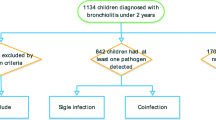Abstract
Bacterial coinfection occurs in pediatric bronchopulmonary infections caused by respiratory syncytial virus (RSV), but the incidence is uncertain. Our subjects are 188 pediatric inpatients having RSV bronchopulmonary infection in two hospitals in Chiba Prefecture between 2005 and 2007. On admission, antigen detection kits using nasopharyngeal aspirate were performed to detect RSV infection and washed sputum bacterial culture was performed to detect bacterial infection. Of the 188 pediatric inpatients with RSV bronchopulmonary infection, 95 (50.5%) patients were aged less than 1 year, 57 (30.3%) were aged 1–2 years, and 36 (19.1%) were aged 2 years or more. Thirty-six (19.1%) patients were associated with bronchial asthma attacks. Pathogenic bacteria were predominantly isolated from 43.6% of the patients. The three most frequently isolated bacteria were Haemophilus influenzae (43.9%), Streptococcus pneumoniae (36.6%), and Moraxella catarrhalis (29.3%). We found that 38.9% of H. influenzae strains were β-lactamase-nonproducing ampicillin-resistant strains. All S. pneumoniae strains were penicillin G (PcG) sensitive. However, 21.9% of S. pneumoniae strains showed PcG minimum inhibitory concentration values of 2 μg/ml. RSV bronchopulmonary infections in hospitalized children are often associated with antimicrobial-resistant bacterial infection in their lower airways. These results indicate that we should be aware of bacterial coinfections in the management of pediatric inpatients with RSV bronchopulmonary infection.


Similar content being viewed by others
References
Thorburn K, Harigopal S, Reddy V, Taylor N, van Saene HK. High incidence of pulmonary bacterial co-infection in children with severe respiratory syncytial virus (RSV) bronchiolitis. Thorax. 2006;61:611–5.
Resch B, Gusenleitner W, Mueller MD. Risk of concurrent bacterial infection in preterm infants hospitalized due to respiratory syncytial virus infection. Acta Paediatr. 2007;96:495–8.
Korppi M, Leinonen M, Koskela M, Mäkelä PH, Launiala K. Bacterial coinfection in children hospitalized with respiratory syncytial virus infections. Pediatr Infect Dis J. 1989;8:687–92.
Duttweiler L, Nadal D, Frey B. Pulmonary and systemic bacterial co-infections in severe RSV bronchiolitis. Arch Dis Child. 2004;89:1155–7.
Kneyber MC, Blussé van Oud-Alblas H, van Vliet M, Uiterwaal CS, Kimpen JL, van Vught AJ. Concurrent bacterial infection and prolonged mechanical ventilation in infants with respiratory syncytial virus lower respiratory tract infection. Intensive Care Med. 2005;31:680–5.
Randolph AG, Reder L, Englund JA. Risk of bacterial infection in previously healthy respiratory syncytial virus-infected young children admitted to the intensive care unit. Pediatr Infect Dis J. 2004;23:990–4.
Bartlett JG, Finegold SM. Bacteriology of expectorated sputum with quantitative culture and washed technique compared to transtracheal aspirates. Am Rev Respir Dis. 1978;117:1019–27.
Cao LD, Ishiwada N, Takeda N, Nigo Y, Aizawa J, Kuroki H, et al. Value of washed sputum gram stain and culture for management of lower respiratory tract infections in children. J Infect Chemother. 2004;10:31–6.
Murayama K, Yamazaki T, Ito A, Uehara S, Sasaki N. Simplified semiquantitative culture using washed sputum from children with lower respiratory tract infections. J Clin Pathol. 2005;58:896.
Saadah HA, Nasr FL, Shagoury ME. Washed sputum gram stain and culture in pneumonia: a practical tool for the clinician. J Okla State Med Assoc. 1980;73:354–9.
Uehara S. A method of bacteriological examination of washed sputum in infants and children. Acta Pediatr Jpn. 1988;30:253–60.
Bloomfield P, Dalton D, Karleka A, Kesson A, Duncan G, Isaacs D. Bacteraemia and antibiotic use in respiratory syncytial virus infections. Arch Dis Child. 2004;39:363–7.
Hall CB, Powell KR, Schnabel KC, Gala CL, Pincus PH. Risk of secondary bacterial infection in infants hospitalized with respiratory syncytial viral infection. J Pediatr. 1988;113:266–71.
Kuppermann N, Bank DE, Walton EA, Senac MO Jr, McCaslin I. Risk for bacteremia and urinary tract infections in young febrile children with bronchiolitis. Arch Pediatr Adolesc Med. 1997;151:1207–14.
Purcell K, Fergie J. Concurrent serious bacterial infections in 2396 infants and children hospitalized with respiratory syncytial virus lower respiratory tract infections. Arch Pediatr Adolesc Med. 2002;156:322–4.
Titus MO, Wright SW. Prevalence of serious bacterial infections in febrile infants with respiratory syncytial virus infection. Pediatrics. 2003;112:282–4.
Todd JK. Antibiotics for respiratory syncytial virus infection. Pediatr Infect Dis J. 1990;9:754.
Heiskanen-Kosma T, Korppi M, Jokinen C, Kurki S, Heiskanen L, Juvonen H, et al. Etiology of childhood pneumonia: serologic results of a prospective, population-based study. Pediatr Infect Dis J. 1998;17:986–91.
Juvén T, Mertsola J, Waris M, Leinonen M, Meurman O, Roivainen M, et al. Etiology of community-acquired pneumonia in 254 hospitalized children. Pediatr Infect Dis J. 2000;19:293–8.
Virkki R, Juven T, Rikalainen H, Svedström E, Mertsola J, Ruuskanen O. Differentiation of bacterial and viral pneumonia in children. Thorax. 2002;57:438–41.
Wubbel L, Muniz L, Ahmed A, Trujillo M, Carubelli C, McCoig C, et al. Etiology and treatment of community-acquired pneumonia in ambulatory children. Pediatr Infect Dis J. 1999;18:98–104.
Korppi M, Launiala K, Leinonen M, Häkelä PH. Bacterial involvement in laryngeal infections in children. Acta Paediatr Scand. 1990;79:564–5.
Mäkelä MJ, Puhakka T, Ruuskanen O, Leinonen M, Saikku P, Kimpimäki M, et al. Viruses and bacteria in the etiology of the common cold. J Clin Microbiol. 1998;36:539–42.
Cao LD, Ishiwada N, Takeda N, Kohno Y. Antimicrobial susceptibility of respiratory Haemophilus influenzae strains isolated from pediatric respiratory tract infections. Pediatr Int. 2004;46:419–24.
Avadhanula V, Rodriguez CA, Devincenzo JP, Wang Y, Webby RJ, Ulett GC, et al. Respiratory viruses augment the adhesion of bacterial pathogens to respiratory epithelium in a viral species- and cell type-dependent manner. J Virol. 2006;80:1629–36.
Avadhanula V, Wang Y, Portner A, Adderson E. Nontypeable Haemophilus influenzae and Streptococcus pneumoniae bind respiratory syncytial virus glycoprotein. J Med Microbiol. 2007;56:1133–7.
Jiang Z, Nagata N, Molina E, Bakaletz LO, Hawkins H, Patel JA. Fimbria-mediated enhanced attachment of nontypeable Haemophilus influenzae to respiratory syncytial virus-infected respiratory epithelial cells. Infect Immun. 1999;67:187–92.
Author information
Authors and Affiliations
Corresponding author
About this article
Cite this article
Hishiki, H., Ishiwada, N., Fukasawa, C. et al. Incidence of bacterial coinfection with respiratory syncytial virus bronchopulmonary infection in pediatric inpatients. J Infect Chemother 17, 87–90 (2011). https://doi.org/10.1007/s10156-010-0097-x
Received:
Accepted:
Published:
Issue Date:
DOI: https://doi.org/10.1007/s10156-010-0097-x




